#eco friendly food plates
Explore tagged Tumblr posts
Text
Why Indian Wholesalers Are Turning to Eco-Friendly Plates and Bowls

Introduction
The rising environmental consciousness among consumers and the global shift toward sustainability have sparked a significant transformation in the tableware industry. In India, this change is particularly noticeable as wholesalers embrace eco-friendly plates and bowls to meet both domestic and international demand. Let’s explore why this shift is happening and how it is redefining the wholesale market.
1. Growing Consumer Awareness and Demand
Indian consumers are increasingly aware of the environmental impact of single-use plastics. The need for sustainable alternatives has encouraged people to adopt eco-friendly plates and bowls for their everyday use, especially for events and catering services. This demand has created a lucrative opportunity for wholesalers, who are aligning their inventories to cater to the rising interest in biodegradable and compostable products.
2. Government Policies Supporting Sustainability
The Indian government has implemented stringent regulations, including bans on single-use plastics, to promote sustainability. These measures have pushed businesses to adopt environmentally friendly practices. For wholesalers, stocking eco-friendly plates and bowls is not just a trend but a necessity to comply with these policies. Additionally, government incentives for green businesses have made it more appealing for suppliers to switch to sustainable tableware options.
3. Cost-effective and Readily Available Materials
India’s abundant natural resources, such as sugarcane bagasse, areca palm leaves, and bamboo, provide cost-effective raw materials for manufacturing eco-friendly plates and bowls. These materials are renewable, biodegradable, and locally available, reducing production costs and enabling wholesalers to offer competitive pricing. This affordability is a key factor in attracting bulk buyers, both domestically and internationally.
4. Catering to Export Markets
Global demand for sustainable tableware is growing, especially in regions like Europe and North America, where environmental regulations are stringent. Indian wholesalers are capitalizing on this opportunity by exporting eco-friendly plates and bowls to these markets. The cost advantage of Indian products combined with their high quality makes them a preferred choice for international buyers.
5. Enhancing Business Reputation
For wholesalers, adopting eco-friendly plates and bowls is not just a business decision—it’s a branding opportunity. Supplying sustainable products helps wholesalers build a reputation as environmentally responsible businesses, attracting eco-conscious clients. This shift also aligns with the values of younger generations who prioritize sustainability in their purchasing decisions.
Conclusion: A Sustainable Future for Wholesalers in India
The shift to eco-friendly plates and bowls is more than a market trend; it is a movement toward a sustainable future. For Indian wholesalers, this transition presents a chance to cater to evolving consumer preferences, comply with regulations, and expand their reach in international markets.
By embracing eco-friendly plates and bowls, wholesalers not only contribute to environmental preservation but also position themselves as leaders in the growing sustainable tableware market. The time is now for Indian wholesalers to take the leap into sustainability and reap the benefits of this transformative change.
#biodegradable food containers manufacturer#biodegradable food containers with lids#sugarcane food container#bagasse food packaging#biodegradable food container#5 compartment disposable plates#biodegradable tableware#eco friendly plates and bowls
1 note
·
View note
Text
Your One-Stop Shop For Eco-Friendly & Disposable Food Packaging

Are you trying to find solid wholesale food containers for your bsuiness ? To meet your needs in food packaging, we offer an inventory of burger boxes, white paper plates, and salad containers. We provide single-use plastic food containers that are best for cafes, restaurants, and catering services. Check out our collection of sustainable food containers for those who are looking for greener options that don't sacrifice quality. Browse Our Collection and Place Your Order Today from: www.polymeruk.com
#Wholesale Food Containers#Salad Container#Burger Boxes#White Paper Plates#Disposable Plastic Food Containers#Eco-Friendly Food Containers
0 notes
Text
#biodegradable products#biodegradable plates#bagasse plates#sugarcane plates#compostable plates#sugarcane bagasse plate#sugarcane disposable plates#sugarcane pulp plates#biodegradable food containers#eco friendly disposable plates#biodegradable containers
0 notes
Note
I feel like if you're using a lot of disposable plastic bags in your day to day life, you've gotta do something sustainable to make up for it. Like using bamboo toilet paper or eco friendly cat litter or something, yknow
Honestly I exaggerate for comedic effect, while I DO routinely use ziplock bags to hold spaghetti I cook maybe once a month and the bag itself is usually for freezer storage. I actually throw out maybe one bag a week? I DO hate washing plates and tupperware and junk but that usually just means I eat sandwiches without a plate.
I agree though that needless waste should be avoided, and I do avoid it- biodegradable bags and recyclables, empty butter tubs used to store leftovers, etc.
This said, though, not applicable necessarily for myself but for a lot of others- I feel that it's importat to remember that there are many people who legitimately NEED things like plastic straws, or catheters, or pre-packaged foods
And the idea that that's a moral failing that individuals need to personally make up for when a single billionaire blows out more CO2 in a long weekend than I will in my whole life on a superjet meet-cute in the Bolivian rainforest between humvee drag races funded by the river-polluting textiles plants they planted in a third world country to avoid EPA laws and give an entire village stillbirths and stomach cancer is an idea that those very same bigwigs have spent a LOT of time and money investing in planting in the public psyche.
Like- Glass bottles are infinitely recyclable, so why are so many drinks in plastic now? Loads of drinks manufacturers used to buy them back and clean them for re-use, so why did they stop? If they chose to make something out of a limited and environmentally irresponsible material, why is it my failing to track down a correct process of disposal for them? What if there are none in my area? Do I lobby for more recycling plants in my area? Do I set aside some of my limited time outside the pain factory of my job- which I have more than one of, thanks to rising costs of things just like that drink I just emptied- to properly dispose of this company's waste FOR them?
Say coca-cola just rolled up to your town and started dumping millions of empty plastic bottles in the street, going, "wow, you should really think about building and staffing a recycling depot, it would be really shameful of you to just put these in the trash." When companies purposefully use materials with limited lifespans- because yes, even plastic can only be reused so many times- and tell you it's your own fault if it harms the environment- that's essentially what they're doing, just with more steps.
Yes, its important to be as environmentally concious as we can in our day to day life, but responsible sustainability is not catholicism. We don't get good boy points from our lord and savior Captain Planet every time the average low-income household gathers together to hold hands and repent for a single-use plastic that allows them to access something they need.
Entire families could eat trees and shit dead lithium batteries for years and still not do as much damage to the planet as an average dye plant or braindead celebrity does in a week just for fun, and I'm mad about it
...this went on longer than intended.
TL/DR: DO recycle and minimize waste, but don't beat yourself up over the little waste you can't avoid, and follow the money.
EDIT: Part 2
#I swear to god if any one of you in the notes calls me terminally online or pretends I'm saying you can just dump bags in the ocean#Yes definitely do your best to live sustainably#But also#You personally are not killing pandas#Unless you are in which case please stop#We put too much money into pandas but let them go in peace#Go do some yoga#Sorry if this is a lot but I have a friend with OCD who has legit panic attacks over stuff like this#Like they have to throw out a ripped plastic grocery bag they've had for six years instead of using it to weave yard furniture or smthn#And they'd go into a spiral about killing the planet#So like#I have strong feelings now
1K notes
·
View notes
Text
SiliNOT! Testing and Review
Since I run a lot of casting workshops, I've had several people in the costuming/maker community ask me my opinion on SiliNOT!, a relatively new product advertised as a budget- and eco-friendly moldmaking alternative to silicone, urethane, and other single-use materials.
I finally bought a couple of bottles to play with, so I did a test project. My experience and findings are below! (It's not a recipe blog, but if you want to skip the play-by-play and get to the TL;DR, it's under the big "In Summary" header near the bottom.)
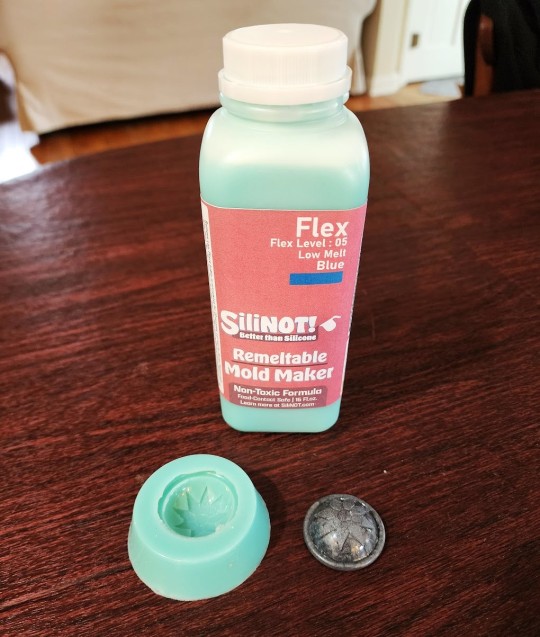
First, if you aren't familiar with this material, SiliNOT! is a remeltable, reusable medium for making molds. Though its exact ingredients are not disclosed, it purports to nontoxic, food-safe, and compostable. It melts in a household microwave or double boiler and solidifies at room temperature (or in a refrigerator/freezer for faster results). The website is https://silinot.com/.
(I am not an affiliate, and have no connection to this company apart from having made one retail purchase from them. I just have a lot of casting experience and like trying out new products.)
The Positive Original
I’m still in the middle of a Vincent Valentine build, so I decided to test the SiliNOT! on his custom buttons. My original is a stack of various nonporous materials: an antique (probably Bakelite) coat button, an epoxy resin dome I cast using a mold I already had in my library, and some engraved Worbla’s Pearly Art for the raised detail. The button shanks won’t be added until the final casting, so the original can be mounted flat for the moldmaking process.
Sample Worbla on the left; completed button stack on the right:
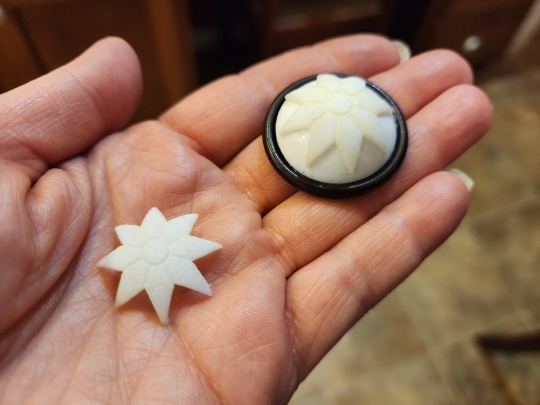
The Mold
I built the mold container the same way I do for silicone pours, with the flat back of the button fixed to a styrene plate and a cylinder (actually a small paper cup with the bottom cut off) surrounding it for the walls. The lip of the cup is sealed all the way around with Monster Clay to prevent leaks.
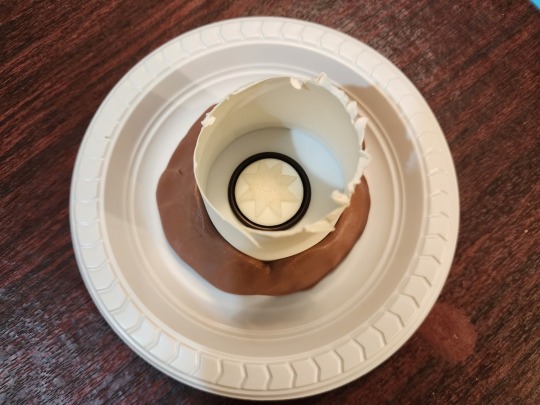
Heating and Pouring
The SiliNOT! didn’t take long at all to heat up; I did maybe four or five 20-second bursts before it was completely fluid. The bottle does get rather warm, so hand protection isn’t a bad idea. If you have heat-resistant gloves, you can use those; I was working in my kitchen (yay for nontoxic stuff!), so I just grabbed an oven mitt with a silicone grip.
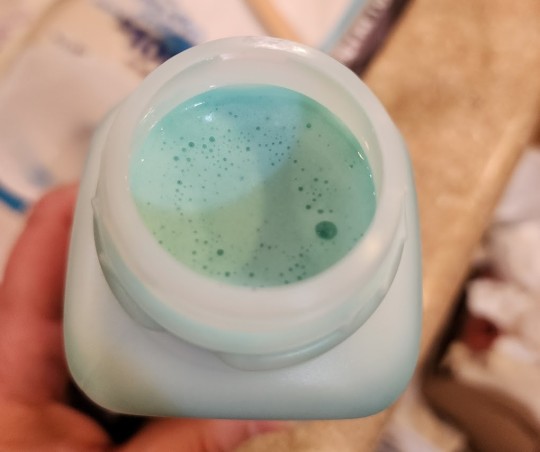
The melted SiliNOT! looks a bit like Luke Skywalker’s blue milk. It’s about the consistency of a yogurt smoothie and likes to pour in a thicker stream compared to silicone. While silicone can be stretched into a thin ribbon for delicate pours or chemically thinned with solvent for really tricky jobs, SiliNOT!'s viscosity is dependent on temperature and never seems to get quite as thin as silicone.
I’d automatically made my mold compact to conserve material (not really a concern with a reusable moldmaking material like SiliNOT!, but after using silicone for more than a decade, I’ve trained myself to be as efficient as possible), so the walls of my mold container were only about half or three quarters of an inch from my object. Because the target was so narrow, I found it difficult to accurately fill from the lowest area of the mold with the SiliNOT! The heavier pour also means more air can get trapped in or under the material.
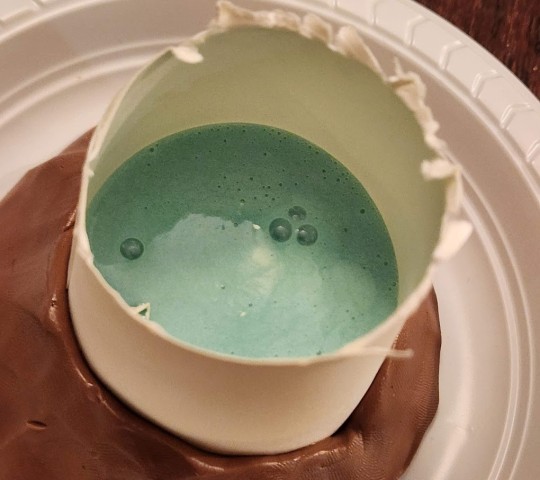
Bubbles are one of the areas in which SiliNOT! is decidedly inferior to silicone. SiliNOT! has higher viscosity, so bubbles don’t want to rise to the surface without vigorous tapping, which can distort the mold edges or affect leveling depending on your mold container. The bubbles that do make their way to the surface are difficult to pop, even when poked with a sharp implement. Heat gun degassing doesn’t have much effect.
Since the bubble surface cools and skins over quickly, I actually had to use a tool and scoop some large bubbles completely out of the mold to allow the surface to level. Critically, the SiliNOT! is opaque, so you can’t spot bubbles clinging to the surface of your original. (This is why my first mold was a reject, and I had to repour. More on that below.)
Hardening
Once the surface had set, I carefully moved the mold into the refrigerator to cool faster. Here’s another area where some types of silicone can have an advantage: I typically use fast-curing Smooth-On products (because I always have random quantities left to use up after our casting workshops), so I rarely have to wait more than half an hour for a silicone mold to cure, regardless of its size or mass.
The SiliNOT! has to chill completely before handling, though, and discharging that amount of heat requires a fair amount of time even in a cool environment. My mold was pretty small, maybe 2 1/2” wide by 1” deep, and it still took around 40 minutes to cool completely. A larger, deeper mold could hold considerably more energy in the center, and might have to be left in the freezer for a couple of hours before use.
Demolding the Original
When the mold was completely chilled, I removed it from the refrigerator and popped it off the plastic plate I’d used for the base of the mold. The texture was very different from what I’d expected: Unlike other meltable materials (Monster Clay, et al.) that have a firm surface when cool, the SiliNOT! remains tacky, which means it promptly collects any debris that crosses its path. In my case, this meant I had to pick dog hair off the surface throughout the casting process (and I don’t want to think about what would happen if glitter had contaminated the work space).
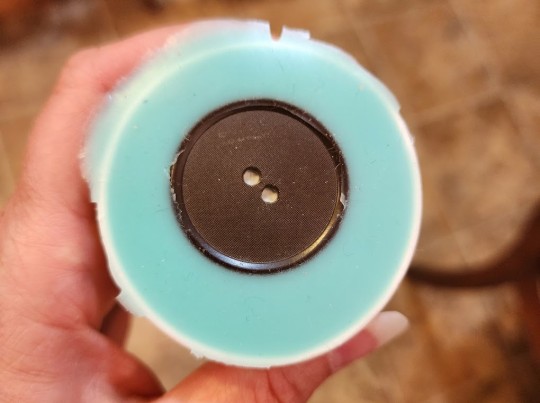
I’d used a paper cup for my mold walls, which usually works fine with fast-curing silicone. But the SiliNOT! must have a high oil content, because the cup absorbed some of it:
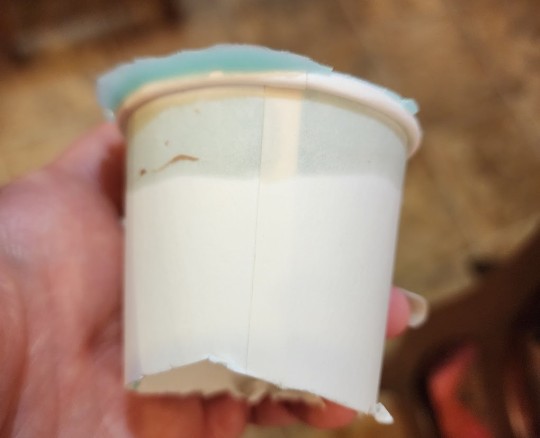
Lesson learned; use only nonporous containers with this stuff.
The SiliNOT!! really wanted to cling to the edges of my original, so I had to go slow at first to avoid tearing the thin flanges of the mold off. However, it did demold nicely from the smooth surfaces, and preserved texture very well. You can see the Worbla pebbling and the engraving channels clearly in the mold (as well as some dust and dog hair, because I made the mistake of setting it down briefly):
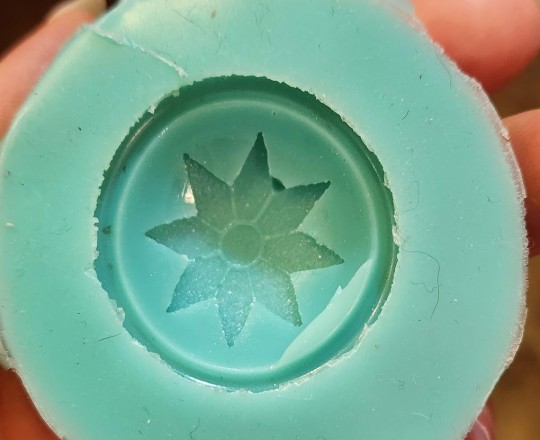
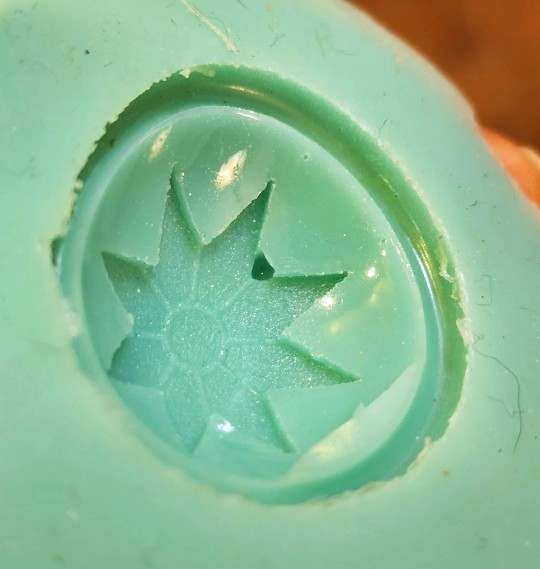
Unfortunately, as you can see, a large bubble had stuck to my original and created a pit in the mold, so I decided to do a second mold pour. I figured I’d tear up the failed mold and put the pieces back in the bottle to remelt… and discovered I couldn’t. The mold would stretch and twist, but not tear. It also seemed to return to its original shape relatively faithfully. Here’s a video of me manhandling the mold:
As you can see, the SiliNOT! has much better stretch and recovery than many silicone products (there are silicones that stretch well -- some of the Dragon Skin products come to mind -- but they’re not typically marketed for moldmaking). This means it’s likely well suited to casting objects with moderate undercuts or oddly-shaped bits that need the mold to stretch during demolding.
You can cut the SiliNOT! easily with scissors, which is the recommended method for getting it back in the bottle when you’re ready to remelt.
Take Two
Using what I’d learned from the first pour, I did the second one inside a hard plastic ramekin. This gave me a bit more room to pour into the floor of the mold, reducing the bubble risk, and also eliminated the porous paper cup that had absorbed oil. I still had the issue with bubbles that didn’t want to pop, but there were fewer of them this time.
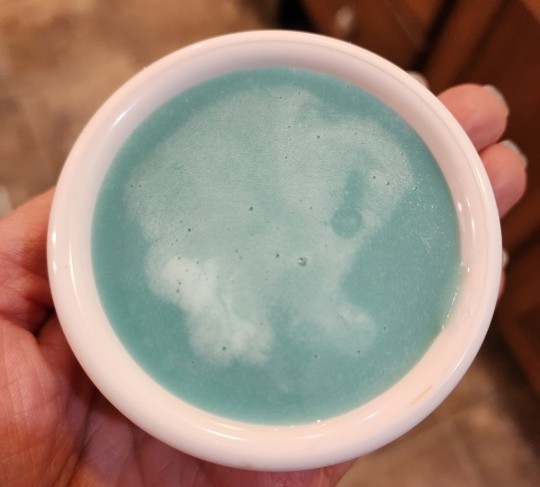
The ramekin made for a much cleaner mold, buuuuut there was ANOTHER BUBBLE right in the middle of the design. >.<
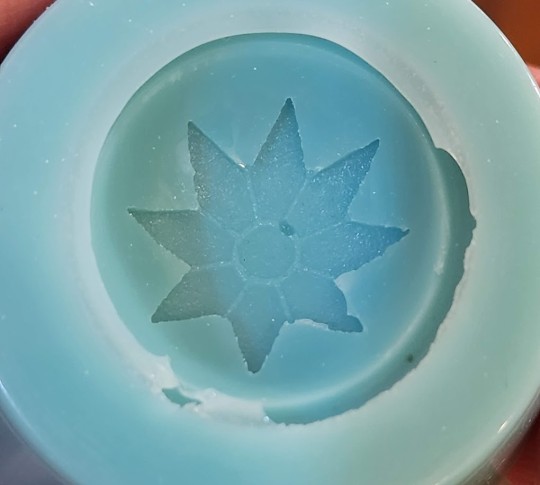
Take Three
Lather, rinse, repeat. Or in this case, melt, pour, chill.
This time I heated the SiliNOT! as much as I dared and did the absolute slowest, narrowest pour I could manage, giving the air extra time to escape as the mold was filled from the bottom. The risk with stringing out the pour like this is that in a thinner stream, the heat escapes faster, leading to uneven viscosity as the liquid fills the mold. I don’t think that’s a major problem for this particular piece, but it’s something to pay attention to as regards leveling and degassing, especially for larger molds that will take longer to fill.
The result of pour three:
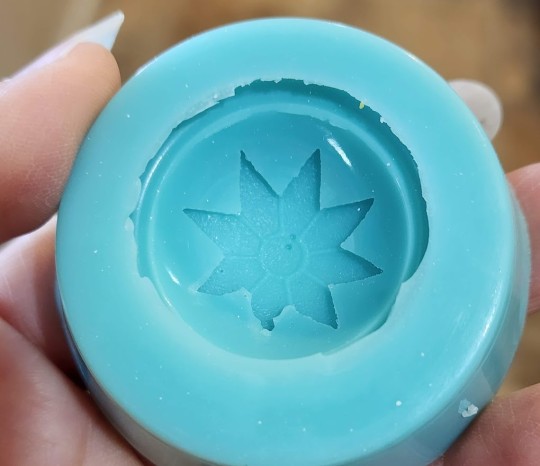
/siiiiigh/ Well, at least the bubbles are smaller, this time. They may not show up enough to matter in the final cast. I’ll give it a try.
Casting
I had leftover workshop resin that was getting on toward the end of its shelf life, so I used Smooth-On Smooth-Cast 300 for my initial resin trial. It’s an opaque white resin with about a 10-minute cure time (the fast turnaround is why we use it for workshops).
Before pouring, I had to do a little mold cleanup where the SiliNOT! had managed to sneak under the edge of the Worbla (I think I’d loosened the corner of the star from prying it out of so many molds), but since the SiliNOT! stretches so well, it was pretty easy to invert it to get little scissors down into the bottom of the depression.
For the first cast, I didn’t use anything but the resin in order to get a baseline. Ideally I’d like to cold cast or dye the resin so I don’t have to worry about paint chipping, but since I’m doing a trial here (and need multiple buttons anyway) I figured some plain white extras wouldn’t hurt.
So, my first cast…
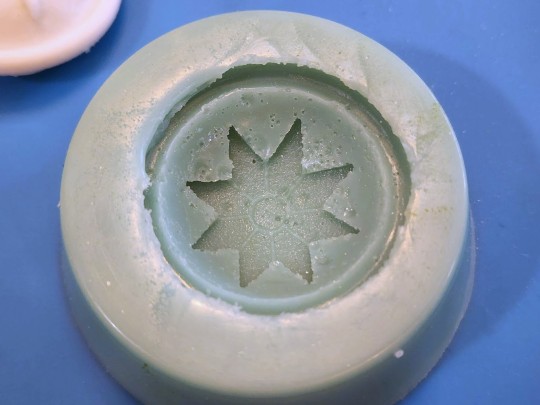
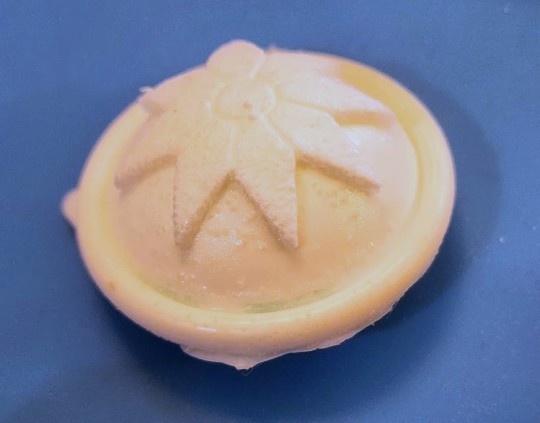
…smacked into a big problem, which I probably should have seen coming: The resin I’m using is a fast cure formula, which means it discharges a fair amount of heat as it's going through that rapid chemical reaction -- enough heat to melt the SiliNOT!, as it turned out. When I tried to demold it (after giving it a few extra minutes beyond label time to be sure it was done), the surface of the mold had melted to the resin and even embedded itself in a few places. It’s difficult to see the resin detail in the photos (my camera went into white balance panic mode with all the shades of white and blue), but you can see how pitted the formerly-smooth mold surface is.
In fairness to the SiliNOT!, the bottle does say that you should put the mold in the freezer for half an hour before casting high-temperature materials. But I assumed high-temperature material was something like candle wax or melted chocolate, rather than ordinary resin. (And the mold had just come out of the refrigerator.)
So, on to pour FOUR of the SiliNOT! mold…
Take Four
NGL, this is getting a little old. >.<
Fourth mold definitely needed some cleanup around the edges, and there are still a couple of tiny bubbles I can’t seem to get rid of, but it’s good enough for a test. (I’m starting to despair of using these for actual production, given how many times I’ve had to redo the molds because of bubbles...)
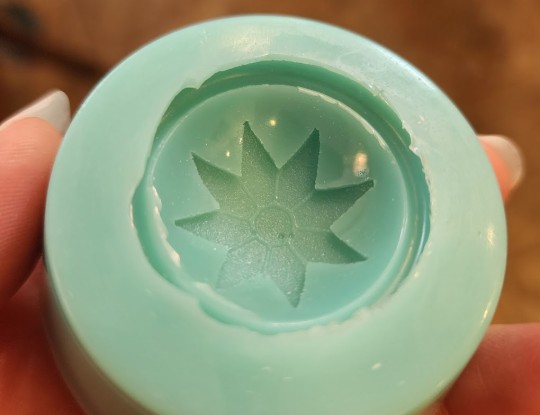
Deep in the recesses of my basement, I found some transparent epoxy resin with a 24-hour cure time -- much slower and lower-temperature than the Smooth-Cast. Since it cures clear, I went ahead and mixed in some metallic powder pigment on the off chance that I get a usable button out of this one. I had excess resin after mixing, so I poured that into my first mold, which has a bubble in the design but is otherwise fine. Two test pieces are better than one, right?
Results
Here are the results of the slow-curing resin out of mold #4:
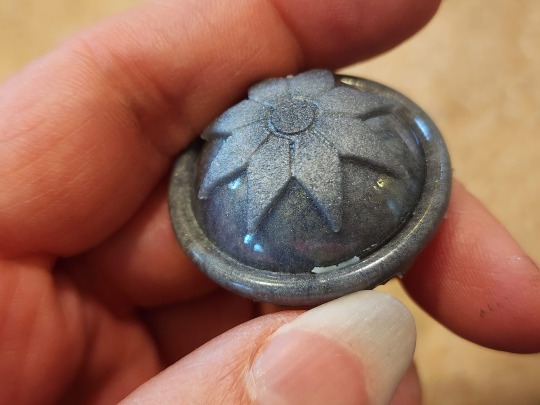
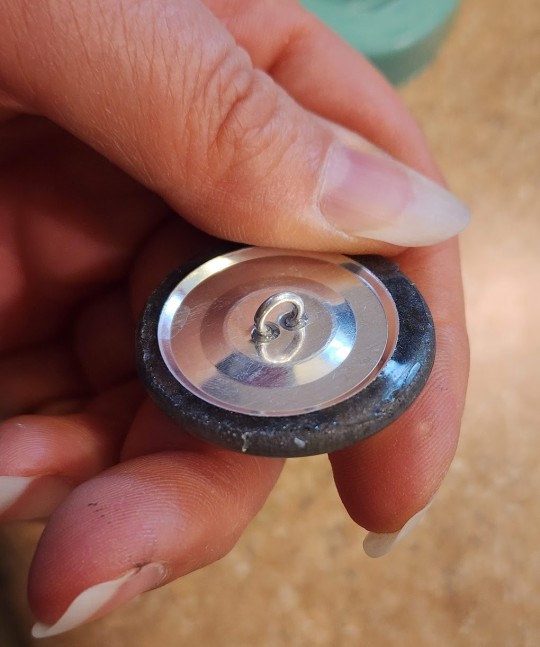
Finally, a (mostly) clean cast!
As you can see, the detail reproduction is excellent -- certainly on par with the pulls from the silicone mold I ended up making while waiting on this set to cure (purely for time reasons; I couldn’t afford five days to cast the buttons using slow-curing resin, and with a silicone mold and fast-curing resin I could get them all done within a couple of hours).
However, you can also see a few spots where bits of the SiliNOT! embedded themselves in the final cast. Part of that may be due to design flaw in the original; I didn’t want to glue anything permanently to the antique button, and that resulted in a tiny gap between the button and the resin hemisphere. Silicone has enough strength to resist tearing out in that kind of area, but apparently the SiliNOT! doesn’t. The bits of mold around the outer edge seem to have stuck just to be difficult, as there was no structural reason for those to have become embedded in the resin. This means the mold could be damaged by successive casts, reducing its usable life and accuracy.
Still, the mold definitely produced decent results for a first cast, and a different shape might not have had as much of a problem with tearing off mold parts. The slow-curing resin is a bit of a limitation, but not a unique one (I use this same epoxy resin for any glass-clear casts I do, and only use the Smooth-Cast 300 for opaque items or things I need very quickly). I don’t personally use UV resin, but I’d be curious to learn how it performs with the SiliNOT!
IN SUMMARY:
Here’s the TL;DR on SiliNOT!
Pros
Cost effectiveness. This is the most obvious advantage of SiliNOT! over silicone; it’s (theoretically) infinitely reusable, and even with natural attrition/inevitable contamination from use, you can likely get over a hundred pours out of a bottle. That's a lot cheaper per use than silicone.
Non-toxicity. SiliNOT! is touted as food contact-safe, so you don’t have to panic if you get it on your skin or kitchen counters. While platinum-cure silicone is also relatively harmless (some varieties are labeled for food or life casting), other common moldmaking materials such as tin-cure silicone or urethane are not. (NOTE: Since the company is very hush-hush about what actually makes up the SiliNOT! secret formula, I do not know if it might release any vapors or fumes that would be irritating or harmful to pet birds. In general, I advise not doing any kind of casting around birds.)
Eco-friendliness. This is the biggest draw for me personally: Given the number of casting workshops I run and all the things I sell commercially, I have constant guilt about the amount of waste I generate for creative projects. In most areas of life I’m an aggressive reduce/reuse/recycler and try to use organic materials instead of synthetics whenever possible, so a mold that’s reusable and compostable is very appealing.
Ease of use. It’s honestly pretty hard to mess this up -- just microwave according to the directions and pour. No measuring, no A/B mixture, no concerns about chemical contamination from latex or sulfur, etc.
Shelf life. Unlike silicones, which have a shelf life of anywhere from six months to three years depending on storage conditions, the SiliNOT! purports to be shelf-stable. It's compostable, so don’t bury it in your yard, but otherwise it appears that it could be kept on hand for years.
Cons
Bubbles. Honestly the most irritating thing about this stuff for me. I’m used to being able to see bubbles forming as I pour, tap them to the surface, and remove them. The fact that I poured four molds of the same object and never once got one without bubbles is super irritating.
Stickiness. I’m not a big fan of the tacky surface texture, and while I haven’t done any cold casting yet, I can imagine that it would be very difficult to clean out any pigment or mica powder that got where you didn’t want it. I probably wouldn’t use this for any kind of cold casting that required isolated colored areas or changing colors between casts.
Set time. The SiliNOT! may take longer to cool than a fast silicone would to cure when dealing with larger molds, so it’s not ideal for projects with a really tight turnaround. (But cosplayers would never be casting something the night before a con, right? We always plan ahead and never, ever procrastinate!)
Library life. The SiliNOT! may or may not structurally degrade over time the way urethane, latex, and tin cure silicones do, but I noticed even in my very limited casts that it was prone to having tiny bits of the mold (particularly at edges) stick and pull off. While I keep most of my platinum silicone molds for years and reuse them, I don’t feel that the SiliNOT! molds would hold up to repeated casting, and they’re far more sensitive to ambient temperature, so they’re probably best used for short term only. (I also wonder about the possibility of oil leaching out in long-term storage.)
Comparative Ranking
Ranking it against other mold-making materials, I’d place SiliNOT! below platinum-cure silicone in terms of performance, but maybe somewhere in the neighborhood of urethane and tin-cure silicone. It's definitely superior to latex. (Though to be honest, I'd rank Play-Doh above latex. I hate working with that stuff.)
Factoring in cost and environmental impact, it beats out urethane and tin-cure silicone. I'm still not sure if I'd rank it above platinum-cure silicone, though... Silicone costs much more and isn't eco-friendly, but the performance and lifespan is significantly better, so it still makes more sense for some projects.
Alginate is another type of material entirely, but in some ways SiliNOT! is comparable to it -- both are more cost-effective than silicone, both are biodegradable, both are skin safe, and both have long shelf lives. But SiliNOT! is easier to use for beginners than alginate, which has to be mixed to the right consistency and has an extremely short lifespan once poured.
Overall, I would recommend SiliNOT! for:
People who want accurate, non-shrinking molds but don’t have the budget for platinum-cure silicone
People who are committed to eliminating waste from single-use materials, and are willing to trade off a little performance for a more eco-friendly material
Projects with smooth surfaces and no indentations/sharp edges/undercuts where bubbles might stick (e.g. cabochons; simple geometric forms)
Projects where you need only one or two casts of something, rather than many casts from the same mold
Casting oddly-shaped pieces around which the mold needs to stretch in order to demold
Use with slow-curing resins that do not generate much heat
I would NOT recommend SiliNOT! for:
Extremely complex or detailed pieces, or pieces with a lot of surface texture that bubbles might stick to
Two-part molds
Projects requiring many identical casts out of the same mold
Molds that you intend to add to your library for future or repeat casting
Use with fast-curing resins, melted wax, melted Monster Clay, or any other material that emits heat
Cold casting with precise color application
My Overall Opinion
It's... okay? I will almost certainly keep SiliNOT! in my toolkit for certain specific applications. It's MUCH cheaper over the long term, I love the idea of recycling mold material, and there are some projects for which it will likely perform very well (those listed in the above bullet points). I will also admit that three days of working with it does not constitute a comprehensive familiarity with the product, and it might be the sort of thing that you get better at working with after more practice. (Just learning how to eliminate bubbles would go a long way toward making me adopt this for more projects!)
However, I don't quite buy the "better than silicone" tagline. It's definitely more difficult to get a perfect result, and there are some projects for which platinum-cure silicone is always going to be more reliable (e.g. high-temperature casting, mass production, large-scale life casting).
For those looking for a recommendation of whether or not to buy, I'd say look at your project budget and the applications for which you're going to be making molds, and let those factors guide which mold material you go with. People doing some kinds of projects are likely going to find this a godsend, while those doing different projects would probably hate working with it.
39 notes
·
View notes
Text
Disposables you can live without
As the attached article says, “eco-friendly living is as much about what you don’t buy as what you do. Reducing your consumption, especially of one-time-use or plastic items, is vital to reducing your ecological footprint.” The article discusses four things, but it only takes a few minutes to think of many other “disposable” items that you can live without. It just takes a little more pre-planning and washing/laundering the reusable items. The four items discussed in the article are disposable razors, dryer sheets, zip-top plastic bags, and paper towels. There is a potential fire safety concern if cloth towels soaked with a lot of cooking grease are dried in a heated clothes dryer after laundering, but for most other uses, cloth towels can be laundered again and again. And you can repurpose old clothing, bath towels, and other fabric items as your cleaning towels. Even if something is biodegradable or compostable, throwing it away after one use wastes the resources used to manufacture it and may create methane in the landfill. Here are a few more items to consider:
Take your own reusable container to the restaurant for your leftover food.
Use your own reusable water bottle or coffee mug whenever possible.
If you use plastic eating utensils for a party, collect them to wash and reuse. Use washable plates instead of paper plates and ask guests to pitch in to wash dishes before they leave. At work, ask employees to bring their own plates and silverware to group meals instead of providing disposables.
This list would not be complete without mentioning reusable grocery and produce bags.
9 notes
·
View notes
Text
Club Feast Brings Flavor and Elegance to Every Occasion

The Perfect Balance of Flavor and Presentation
At Club Feast, we understand that catering is about more than just feeding your guests. It’s about crafting a culinary experience that resonates with every attendee. Our chefs curate menus that are not only delicious but also beautifully presented. From vibrant charcuterie boards to meticulously plated entrées, every dish is a testament to our dedication to quality and artistry.
Our team of chefs draws inspiration from global cuisines, incorporating a fusion of flavors that cater to diverse palates. Each dish is prepared with the freshest ingredients, ensuring that every bite is bursting with taste and quality. Our approach combines the authenticity of traditional recipes with innovative culinary techniques, offering a dining experience that’s both nostalgic and modern.
Customization for Every Occasion
No two events are the same, and neither should their menus be. Club Feast works closely with clients to create customized menus tailored to their specific needs. Hosting a corporate luncheon? We’ll craft a sophisticated menu that impresses your colleagues. Planning a wedding? Our team will design a feast that complements your theme and leaves your guests raving.
Our customization process begins with a consultation to understand your event’s theme, guest preferences, and dietary restrictions. Whether you’re envisioning an elegant sit-down dinner or a lively buffet-style spread, we’ll collaborate with you to bring your vision to life. From appetizers to desserts, every element is thoughtfully designed to align with your event’s unique character.
Catering That Reflects Your Style
We believe that elegance is in the details. That’s why we go beyond the food to ensure every aspect of our service reflects your unique style. From stylish table settings to attentive staff, we strive to create a seamless and polished experience. Whether your event is formal or casual, we’ll ensure that it’s a reflection of your vision.
Our event coordinators work hand-in-hand with clients to curate decor, lighting, and table arrangements that enhance the ambiance. Whether it’s a rustic outdoor wedding, a glamorous black-tie affair, or a casual backyard barbecue, our team ensures that every detail contributes to a cohesive and visually stunning experience.
Sustainable Practices for a Better Tomorrow
Club Feast is also committed to sustainability. We source ingredients responsibly, prioritize seasonal and local produce, and minimize waste wherever possible. By choosing us, you’re not only delighting your guests but also supporting environmentally friendly practices.
Our dedication to sustainability extends beyond the kitchen. We use eco-friendly packaging and strive to reduce our carbon footprint by collaborating with local suppliers. Additionally, any surplus food from events is carefully donated to community organizations, ensuring that nothing goes to waste.
Beyond Food: Creating Memorable Experiences
At Club Feast, we believe that catering is more than just serving food; it’s about creating memories. Our team is passionate about delivering experiences that resonate with guests long after the event is over. From live cooking stations that add an interactive element to elegant wine pairings that enhance each dish, we go the extra mile to make your event stand out.
Imagine your guests enjoying freshly prepared sushi at a live station or indulging in a customized dessert bar featuring artisanal sweets. These personalized touches not only delight guests but also create moments of connection and celebration.
Why Choose Club Feast?
With countless catering options available, you may wonder what sets Club Feast apart. Here are just a few reasons:
Unparalleled Flavor: Our dishes are crafted with fresh, high-quality ingredients and inspired by diverse culinary traditions.
Professional Expertise: From menu planning to event execution, our team handles every detail with precision.
Flexible Options: We cater to a variety of dietary needs, including vegetarian, vegan, gluten-free, and more.
Unforgettable Experiences: Our goal is to make your event stress-free and memorable for all the right reasons.
Testimonials: Hear from Our Happy Clients
Don’t just take our word for it — here’s what some of our clients have to say:
“Club Feast exceeded our expectations! The food was not only delicious but also beautifully presented. Our guests couldn’t stop raving about it!” — Sarah L.
“The team at Club Feast made our wedding day truly special. From the initial consultation to the final dish, everything was perfect.” — James and Emily R.
“We’ve used Club Feast for several corporate events, and they never disappoint. Their attention to detail and professionalism are unmatched.” — David K.
Let Club Feast Elevate Your Next Event
Whether you’re planning a small gathering or a grand celebration, Club Feast is here to bring flavor and elegance to every moment. Let us handle the culinary details so you can focus on what truly matters: enjoying your event with your guests.
Contact us today to start planning your next feast. Together, we’ll create an experience that’s as unique and special as your occasion.
#club feast restaurants#catering for corporate event#artists on tumblr#corporate conference catering#corporate food delivery services#deadpool and wolverine#healthy meals for lunch at work#bill cipher#corporate meals catering#ryan reynolds
2 notes
·
View notes
Text
Why trust professional rice manufacturers for quality?

Rice isn’t just a staple food – it’s a cultural cornerstone for billions of people around the world. Whether it’s the aromatic Basmati from India or the sticky rice from Southeast Asia, the quality of rice can make or break a meal. But have you ever wondered what it takes to ensure that the rice on your plate is of the highest standard? This is where professional rice makers come in. In this blog, we will explore why it’s important to trust experienced rice exporters and suppliers for quality, consistency, and reliability.
How professional rice makers ensure superior quality
When it comes to rice production, experience and expertise are non-negotiable. Professional rice makers, especially renowned Indian rice manufacturers, have decades of knowledge in rice cultivation, processing, and packaging. They understand the nuances of different rice varieties from long-grain Basmati to short-grain Japonica and know how to handle each type to retain its unique characteristics.
For example, Basmati rice requires specific growing conditions and careful milling to maintain its aroma and long grains. Professional producers invest in skilled agronomists and food scientists who ensure that every grain meets stringent quality standards. This level of expertise is difficult to replicate, making trusted rice suppliers the preferred choice for consumers and businesses alike.
Advanced technology and processes for consistent rice quality
Modern rice production is no longer just about traditional farming methods. Professional rice producers leverage advanced technology to maintain consistency and quality. From state-of-the-art milling machines to optical sorters that remove impurities, these technologies ensure that only the best grains make it to your plate.
For example, color sorters use high-resolution cameras to detect and remove discolored or damaged grains to ensure uniformity in every batch. Additionally, automated packaging systems prevent contamination and increase rice shelf life. These innovations are the hallmarks of reliable rice exporters who prioritize quality over quantity.
Certifications and Standards: Why They Matter in Rice Production
One of the main reasons to trust professional rice manufacturers is that they adhere to international certifications and standards. Reputable rice suppliers often hold certifications such as ISO, FDA, and FSSAI, which guarantee that their products are safe, clean, and of high quality.
For example, Indian rice manufacturers who export to global markets must adhere to strict regulations set by importing countries. These certifications not only build trust but also ensure that the rice you eat is free from harmful chemicals and contaminants. When you buy from certified rice exporters, you are investing in peace of mind.
Sustainability and Ethical Practices in Rice Manufacturing
In today’s world, sustainability is a growing concern for consumers. Professional rice manufacturers are increasingly adopting eco-friendly practices to reduce their environmental footprint. From water-saving farming techniques to biodegradable packaging, these efforts contribute to a healthier planet.
For example, many Indian rice manufacturers are adopting organic farming methods, which avoid synthetic pesticides and fertilizers. This not only benefits the environment but also produces healthy, chemical-free rice. By choosing the best rice suppliers committed to sustainability, you support ethical practices that benefit both people and the planet.
The Role of Professional Rice Manufacturers in Global Trade
Rice is one of the most traded commodities in the world, and professional rice manufacturers play a vital role in global supply chains. Whether it's meeting the demand for Basmati rice in the Middle East or supplying Japonica rice to Japan, these manufacturers ensure that high-quality rice reaches every corner of the world.
Reliable rice exporters have strong logistics networks that guarantee timely delivery without compromising on quality. They work closely with farmers to ensure fair pricing and ethical sourcing, building long-term relationships that benefit everyone.
When it comes to something as essential as rice, settling for less than the best is not an option. Professional rice producers bring expertise, technology, certifications and consistency, ensuring every grain meets the highest standards. Whether you are a consumer or a businessperson, trusting reputable rice suppliers is the key to enjoying safe, delicious and ethically produced quality rice.
So, the next time you go to buy rice, remember that behind every grain is a story of dedication, innovation and trust. Choose wisely and enjoy the difference that quality makes.
1 note
·
View note
Text
Ma's Burger Takeout /Sims4 restaurant










Ma's Burger Takeout, restaurant type lot, uses Dine Out & several packs, nocc, for DL on my gallery. {my mother named it :D} Uses some debug & use bb.moveobjects before placing. Fully furnished, realistic look, cluttered & very detailed, cozy little build. Place on movers & shakers lot in Willow Creek.
Grand opening will seat 8 sims, outdoor dining, serving burgers rootbeer & icecream on opening day, even open in rain if you don't mind food getting soggy, probably close up for winter snow season. Friendly service, good food, cozy atmosphere, Canada takeout feel, type of build.
{When I playtested, Mr. frost came to eat, as well as old single mustache horse owner from ranch ep, & Mrs. Crumplebottom was there hanging out with him, happy one minute, crabby the next. It was cute :D . Didn't own the restaurant yet just visited, staff were all nice, had no problem getting food, & didn't have to wait long. It was raining but didn't seem to bother sims. Had Japanese cook & waitress- she was a big kind girl, hope she's my waitress next time I visit, not sure if they get switched out with no owner, I'll find out soon.~ Also, Crumplebottom kicked over my trashcan out back :D what for..}
*Also, different from these screenpics, for the gallery lot, after testing, I moved that outdoor wall stereo from backyard stuff, under the middle roof overhang, since the rain would break it. And replaced fruit garbage plant looking bag near front right garbage with debug black garbabe bag from eco living, or it turns to garbage pile.. & moved the veranda plant slightly and that table on back left near it, slightly, or sims would stay in corner after leaving that table, but in good mood strangely.., hope I moved it enough, didn't test that yet. There's room to move it more if you need to :) & not sure if the lot will come with garbage out back that wasn't picked up yet, & customers left a few glasses & plate on tables.
#sims4#thesims4#sims#nocc#lightsims8#sims4nocc#sims4housebuild#sims4fullyfurnished#sims4detailedhouse#ts4#showusyourbuilds#showmeyourbuilds#sims4dineout#sims4restaurant#sims4takeoutrestaurant#sims4outdoordining#sims4manypacks#sims4realistichouse#sims4clutteredhouse#sims4cozyrestaurant
3 notes
·
View notes
Text
A Guide to Waste Reduction in Indian Weddings

In a world that's becoming increasingly conscious of environmental impact, it's time for weddings to take on a green hue. indian wedding, known for their grandeur, can also be a source of significant waste. However, with a few thoughtful choices, you can turn your wedding into an eco-friendly celebration. Here's a guide to waste reduction in Indian weddings.
Eco-friendly Invitations
Embrace the digital age and send out e-invitations instead of traditional paper ones. Not only does this reduce paper waste, but it also makes it easier for guests to RSVP and stay connected throughout the wedding festivities.
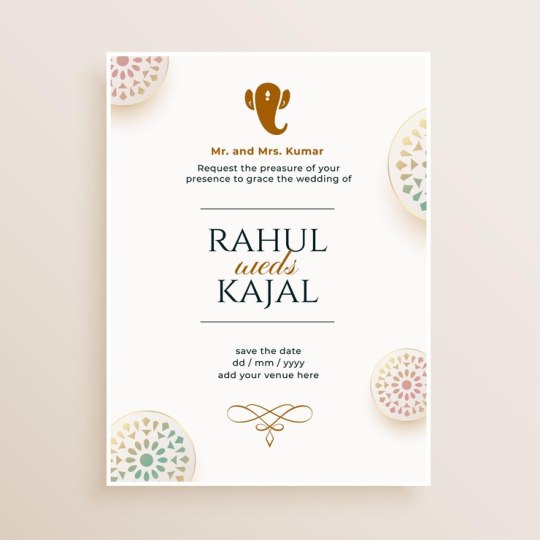
Image courtesy - freepik
Rent Your Outfits:
Consider renting your wedding attire instead of buying it. This not only saves money but also reduces the demand for new clothing production. Many platforms offer the opportunity to rent wedding dresses, allowing you to express your style without contributing to the environmental impact of textile waste.

Wedding Decor:
Opt for local and seasonal flowers for your wedding decor. Not only do they add a touch of freshness, but choosing local blooms also minimizes the carbon footprint associated with transporting flowers over long distances. Consider repurposing decor items or donating them to reduce waste further.

Image courtesy - freepik
Eco-friendly Dining:
Say goodbye to single-use plastic cutlery and plates. Instead, opt for reusable or biodegradable alternatives. This small change can significantly reduce the environmental impact of your wedding, and your guests will appreciate the effort to make the celebration more sustainable.
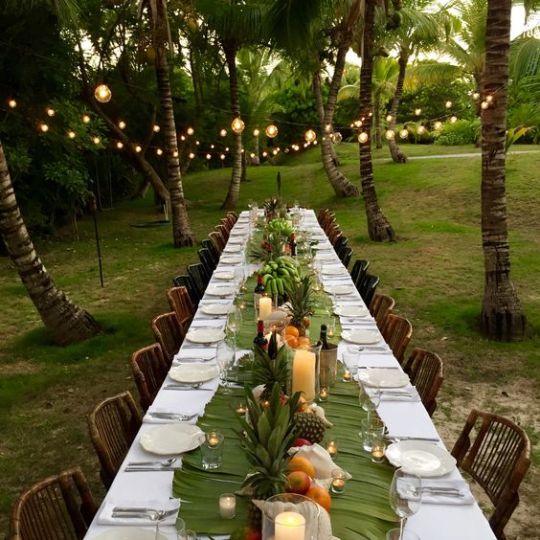
Image courtesy - Shaadiwish
Minimize Food Waste:
Plan your wedding menu carefully to minimize food waste. Work closely with your caterer to estimate portion sizes accurately. Consider donating excess food to local charities or food banks. It not only helps the community but also ensures that the surplus food doesn't end up in landfills.

Image courtesy - bollywoodshaadis
Digital Photo Albums :
Choose a wedding photographer who offers digital photo albums instead of traditional printed ones. This not only reduces the use of paper and ink but also makes it easier for you to share and cherish your memories in a digital format.

Image courtesy - pikperfect
Spread the Green Message:
Share your waste reduction efforts with your guests. Include a small note in your wedding program or have a display showcasing your eco-friendly choices. By doing so, you not only inspire others to adopt similar practices but also contribute to raising awareness about the importance of sustainability in celebrations.
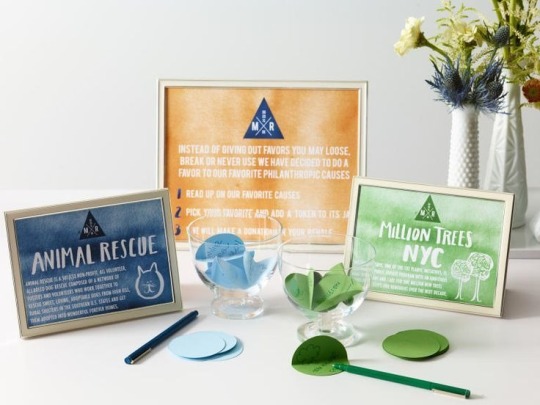
Image courtesy - via The Knot
Your wedding day is a celebration of love, and what better way to express that love than by being mindful of the planet? With these simple yet impactful steps, you can make your Indian wedding a beacon of eco-friendliness, setting a positive example for future celebrations. Let your special day not only mark the beginning of a new chapter in your life but also stand as a testament to your commitment to a sustainable future.
3 notes
·
View notes
Text

🌿🐟 Revolutionizing Home Gardening: Automated Aquaponics for Every Home! 🐟🌿
Greetings, Sustainability Enthusiasts! We’re thrilled to introduce you to the future of home gardening – Automated Aquaponics! Imagine having a self-sustaining ecosystem at your fingertips, providing fresh, organic produce and fish, all within the comfort of your home. 🏡💚
🌱 Why Automated Aquaponics? Aquaponics marries aquaculture and hydroponics to create a harmonious environment where fish waste nourishes plants, and plants purify water for fish. Now, add automation to this, and voila! You have a hassle-free, efficient, and eco-friendly food production system!
🌟 Key Features:
Self-Sustaining: Automation ensures optimal water and nutrient levels, reducing manual intervention.
Space-Efficient: Ideal for urban dwellers, our systems are designed to fit any space, including balconies and backyards!
Bountiful Harvests: Enjoy fresh vegetables, herbs, and fish throughout the year!
🛠️ Customization and Convenience: Our systems are tailored to your needs! Whether you have a penchant for culinary herbs, colorful veggies, or fresh fish, we help you design a system that caters to your palate. Plus, with user-friendly interfaces and remote monitoring, managing your aquaponics system is a breeze!
💡 Sustainability Meets Innovation: Automated Aquaponics is not just about food. It’s a step towards self-sufficiency and environmental stewardship. By utilizing resources wisely, reducing waste, and promoting biodiversity, we’re crafting a greener, healthier future for our planet and our plates!
🌐 Join the Aquaponics Community: Embark on a journey of green living! Connect with fellow enthusiasts, share your harvests, and exchange tips and tricks. Together, let’s cultivate a community that thrives on sustainability and innovation!
🔍 Ready to Dive In? Explore the wonders of Automated Aquaponics at home! Transform your living space into a thriving, green oasis. 🌿🌊
#Aquaponics #Sustainability #GreenLiving #HomeGardening #AutomatedAquaponics #EcoFriendly #Innovation
3 notes
·
View notes
Text
From farm to table: Exploring the role of butchers in the food chain
Are you looking for a butcher near me? When we sit down to enjoy a perfectly cooked steak or savor a delicious roast chicken, we often don't think about the journey that piece of meat took to reach our plate. This journey is a fascinating one, and it involves a key player in the food chain: the butcher. Butchers play a crucial role in bringing meat from the farm to our tables, and their expertise and craftsmanship are vital in ensuring that we have access to high-quality, safe, and delicious meat products.
Sourcing and selection
The journey of meat begins at the farm, where animals are raised for their meat. Butchers are not typically involved in the rearing of animals, but their role comes into play when it's time to select and source the animals for processing. Butchers work closely with farmers and suppliers to ensure that the animals meet the necessary quality and safety standards. They evaluate factors such as the animal's age, size, and overall health to determine if it's suitable for processing into meat products.
Cutting and processing
Once the animals are selected, the next step in the process is cutting and processing. This is where the butcher's skills and knowledge truly shine. Butchers are experts in meat anatomy, understanding the different cuts and how to extract them from the animal carcass. They use specialized knives and tools to separate the meat into various cuts, such as steaks, chops, and roasts, according to customer preferences and culinary needs.
Quality control
Quality control is a paramount concern in the meat industry, and butchers are at the forefront of ensuring that the meat products meet the highest standards. They inspect each cut of meat for freshness, color, marbling, and any signs of spoilage. Butchers also play a crucial role in maintaining the cold chain, ensuring that the meat is stored and transported at the proper temperatures to prevent bacterial growth and maintain its quality.
Customization and customer service
One of the unique aspects of the butcher's role is the ability to customize meat cuts according to customer preferences. Whether you want a thicker steak, bone-in chicken thighs, or a specific portion of a roast, butchers are there to accommodate your requests. They provide personalized customer service, offering advice on cooking techniques, recipes, and the best cuts for specific dishes.
Waste reduction and sustainability
Butchers also contribute to reducing food waste in the food chain. They are skilled at using as much of the animal as possible, creatively repurposing less common cuts into sausages, ground meat, or other products. This not only minimizes waste but also maximizes the value of each animal, contributing to a more sustainable and eco-friendly food system.
Safety and hygiene
Ensuring food safety is a top priority for butchers. They follow strict hygiene and sanitation protocols to prevent contamination and the spread of foodborne illnesses. This includes regular cleaning of equipment and workspaces, proper handwashing, and the use of food-safe chemicals and sanitizers.
Local and artisanal butcheries
In recent years, there has been a resurgence of interest in local and artisanal butcheries. These smaller, specialized shops focus on sourcing meat from local farmers, often with an emphasis on organic and sustainable practices. Local butchers often have a closer connection to their community, providing customers with a direct link to the source of their meat.
In conclusion, butchers are unsung heroes in the food chain, bridging the gap between the farm and our tables. Their expertise, dedication to quality, and commitment to sustainability make them essential players in ensuring that we have access to safe, delicious, and responsibly sourced meat. So, the next time you enjoy a sumptuous meat dish, take a moment to appreciate the vital role that butchers play in bringing that meal to your table.
Gaja Meat - Korean Butcher Shop 2/8-12 Kerrs Rd, Lidcombe, NSW, 2141 (02) 9643 7007
2 notes
·
View notes
Text
N
I'm having a mental breakdown yet again i hate my life. I hate living here. I went upstairs to make myself some food. I opened the trash to throw the packaging away and I noticed right away. The zip lock bag I threw away earlier, that had my breadsticks in it and I had eaten the last one, and threw in the trash, i noticed it was no longer on top of all trash. I panicked right right, knowing this meant my grandpa took it out. Sure enough I found it crumpled up and stuffed in the cupboard. To be reused. I started crying as I cut it up with scissors before putting it back in the trash. Everything in this house is a hazard I don't know what to do. Let me be clear this kind of behavior, reusing disposable bags with food crumbs in them, is not a necessity, these people are not loving in poverty. They have bulky retirement savings for the rest of their life. It's also nothing to do with being eco friendly or reducing waste or whatever. It's literally just excessive penny pinching for no other reason than that. If you've been following my lore you know I'm not just upset about this bag, but the fact that this place is so unsanitary I have been going far out of my way to not get food poisoning, spending MY money on my own disposable plates and utensils, the other day I realized I was getting sick because of the coffee machine being filled from a moldy pitcher of water so I'm no longer using the machine and exclusively biting instant coffee, but nothing I do is enough. I still have to live in a garbage pit and I can't take it. Having to fucking cut up a used zip lock back with scissors so no one takes it out of the trash I can't. I can't do this. But I have no where else to live. I'm stuck living like this. I hate my life
2 notes
·
View notes
Text
Baby Essentials That Grow With Your Child Naturally
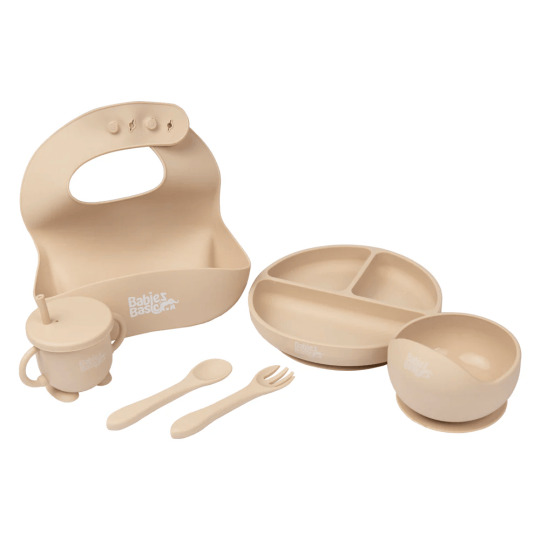
Table of Contents
Introduction
Why Choosing the Right Baby Essentials Matters
Essential Baby Products That Grows with Your Child
Feeding Tools for Every Stage
Sensory Toys and Developmental Play
Everyday Care Essentials
Keepsakes That Capture Every Milestone
Built to Grow: How Our Products Stand Out
Budget-Friendly and Eco-Smart
Conclusion
FAQ
1. Introduction
With the extra years, so do your child's needs—though that doesn't necessarily mean replacing everything they put in their mouths. At BabiesBasic, we're dedicated to offering baby basics that can keep up with every stage of development, from first bites to first steps and all in between. Whether a Silicone Plate Set with Spoon and Fork that makes feeding yourself a cinch or a Personalized Milestone Blanket that keeps every milestone moment, our staples are functional, affordable, plastic-free, and made to last with your child.
Made with gentle, safe materials like food-grade silicone and sustainable cotton, our basics are designed for real life parenting—mess, milestones, included.
2. Why Choosing the Best Baby Staples Matters
All parents want products that are:
Healthy for baby's health
Long-lasting to survive the test of everyday use
Nice on the wallet
Nice on the planet
Most baby products out there are falling short on most of those benchmarks. That's where we're different. Our plastic-free, toxin-free, affordable basics are made to be reused, cherished, and passed down—because babies grow up quick, but good products shouldn't die.
3. Timeless Baby Essentials That Will Test Your Mettle
From time to eat to time to play to time to sleep, here's how our top-selling essentials support your child's development by the ages.
Feeding for every Stage
Pre Feeding Spoon Set
Ideal for baby's first bites, this soft silicone spoon is comfortable for small hands to grip and gentle on tender developing gums. Short handle promotes proper motor skills.
Silicone Bowl & Spoon Feeding Set
The suction base keeps mealtime messes under control, and the coordinating silicone spoon makes it simple for babies to learn to feed themselves.
Silicone Plate Set with Spoon and Fork
As your child grows into a toddler, this sectioned plate makes it easy for them to try new foods while the forks and spoons encourage independent eating.
Silicone Spoon with Travel Case
Ideal for travel families. Soft tip is gentle on mouths of all ages, and the case makes them travel clean.
Stainless Steel Baby Spoon Set / Toddler Cutlery Set
Once your baby is more at ease with eating, move on to a stainless steel spoon set for babies. Designed for toddler-sized hands, it's ideal for learning adult eating techniques.
Sensory Toys and Developing Play
Colouring Mat / Silicone Colouring Reusable Mat
Wipe-clean and reusable, these colouring mats are a creative hand-eye skill and colour recognition ability building experience. Use them for toddler years, and even into early childhood.
Stacking Toys in Silicone
Flexible, safe, colourful—these stackers build with your child from basic stacking to fantasy-building and sorting play.
Daily Life Essentials
Pacifier Clip Personalised
Chew-proof, cool, and useful, our pacifier clips remain a useful tool from teething to toddlerhood—having favourite soothers at hand.
Silicone Toothbrush for Infants
Begin oral care early with our infant-safe silicone toothbrush. Gentle on gums and designed for little mouths, it flows smoothly into toddler oral care.
Mementos That Mark Each Milestone
Personalized Milestoned Blanket / Milestone Twin Blanket
From the early months to the first birthdays, our soft, snuggly blankets are ideal for tracking progress. As baby gets bigger, they become treasured keepsakes or soothing nap blankets.
Style for Mobility and Convenience
Printed Cotton Long Sleeves Sleepsuit
Created to snuggle and sleep, this lightweight suit is warm and comfortable at every stage of early life.
Printed Cotton Long Sleeves Jumpsuit for Babies
Durable enough for playtime and gentle enough for naptime—this snuggly jumpsuit is the ideal option for little movers and shakers.
4. Built to Grow: How Our Products Shine
We incorporate flexibility and long-term usage into our products at their very foundation. See how we design our baby essentials to develop along with your baby:
Flexible designs: Spoons' size, and elasticky clothing, we incorporate flexibility into each element.
Multi-stage functionality: Our products take your child through various stages of development—no upgrades necessary.
Quality materials: We utilize food-grade silicone, stainless steel, and breathable cotton to promote long-term usage.
5. Budget-Friendly and Eco-Smart
Why waste more on short-term plastic products that straight away end up in the waste bin? Our range is:
Economical: Long-lasting, reusable products imply less replacing and better value.
Sustainable: Plastic-free, BPA-free, and environmentally friendly materials cut down on waste.
Timeless: Simple, understated designs make our products ideal to pass down from kid to kid.
6. Conclusion
Your child's childhood is filled with happy moments—and the proper gear makes each step cleaner, simpler, and more enjoyable. Here at BabiesBasic, we produce baby basics that last as long as your baby, serving up first foods, creative play, and nighty-night hugs along the way. From a stainless steel cutlery set for baby or a Personalized Milestone Twin Blanket, our products are designed to make it through more than one phase and hold value much longer than its initial use.
Invest in eco-friendly, safe baby gear that grows up with your baby—because parenting is a journey, and every step is worth the best.
7.FAQ
Q: How old is my baby when they can use the pre-feeding spoon?
Yes.Our Pre Feeding Spoon Set is ideal for baby's first solid food, usually between 4 and 6 months.
Q: Are the coloring mats really reusable?
Yes. Our Reusable Silicone Colouring Mats are easy to clean and reuse time and again using washable markers.
Q: Can I dishwasher the silicone feeding sets?
Yes, all our silicone feeding items are dishwasher-proof and heat-resistant.
Q: What makes the milestone blankets so special?
Yes, our Milestone Personalized Twin Blanket is soft, sweetly printed, and may have your child's name in—ideal for keepsake photo and memory pictures.
#silicone baby products#baby feeding essentials#reusable silicone colouring mat#personalized pacifier clips#silicone plate set#pre feeding spoon set#silicone toys#milestone blanket#baby products#daddy’s babygirl#babies#baby#baby health
0 notes
Text
Why Disposable Bowls Are the Best Option for Helpful Living.
Hello, Guys My name is Disha Roy. I hope everyone is doing well. Disposable bowls provide the ease that is essential in today's hectic society. Disposable bowls are the ideal answer whether you're running a food delivery service, throwing a party, or just wanting to clean up after meals quickly. Eco-friendly leaf products. We offer high-end disposable bowls that are long-lasting, environmentally responsible, and appropriate for every situation.

The rise of disposable tableware
Disposable tableware has grown in popularity due to shifting lifestyles and heightened sanitary awareness. Disposable bowls are among the most useful of these they work well for soups, salads, snacks, desserts, and more.
Disposable dishes are not all made equal, though. For this reason, our business specializes in offering premium bowls that are notable for their longevity, aesthetic appeal, and environmental impact, as well as foil containers.
1. Time-saving and convenient.
The time saved on dishwashing is one of the main benefits of disposable bowls. The last thing you want is to face a mountain of filthy bowls after a long day or an important function. Wooden cutlery Disposable choices allow you to just throw them away and unwind.
2. Sanitary and secure.
Our disposable bowls are manufactured with food-grade materials in sanitary, clean settings. They are perfect for catering businesses and occasions where hygienic conditions are crucial.
3. Sustainable Choices Accessible.
We recognize the significance of sustainability. Because of this, a large number of our bowls are composed of compostable and biodegradable ingredients, such as cornstarch or sugarcane bagasse, which helps to lower carbon emissions and plastic waste.
4. Travel-friendly and lightweight.
Organizing an outdoor event, road trip, or picnic? Picnic plates and bowls are ideal for on-the-go use without sacrificing quality because they are portable, lightweight, and easy to carry.
5. Economical.
Why spend money on pricey tableware that can break or disappear during gatherings? Disposable bowls provide an affordable substitute without compromising on appearance or usefulness.
Where Are Our Disposable Bowls Usable?
Birthday celebrations and wedding ceremonies
Picnics, outdoor gatherings, and food vendors
Eateries and delivery services
Meetings in the office and brief lunch breaks
0 notes
